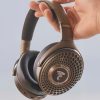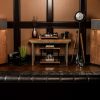Beyerdynamic was founded by Eugen Beyer in 1924 and made its mark with its first series of cinema loudspeakers. Beyer was born in St. Petersburg but the family found itself stranded in Berlin at the start of World War I and after a short period in Sweden, Beyer enrolled at the Technische Universität Berlin.
Beyer named the company “Elektrotechnische Fabrik Eugen Beyer,” and it was his fascination with the motion picture industry that created his desire to add sound to the moving picture shows on the screen; his first products were loudspeakers for movie theaters and the company evolved over the decades into the brand that we have today. The corporate history is a fascinating read that you can find here.
After nearly a century of groundbreaking technological innovation, Beyerdynamic is pushing hard into the gaming space and wireless categories with the $299 Beyerdynamic DT 700 Pro X Headphones and the $249 Beyerdynamic Free Byrd Wireless Earbuds.
The gaming category makes sense for Beyerdynamic because they have a proven track record in the pro audio world where comfort, reliability, and build quality matter greatly to recording professionals who have to use them all the time and they have to be built to withstand a lot of abuse; which is very similar to those who spend far too much time playing console and PC games.
The true wireless category makes sense from a financial perspective; the wireless segment is projected to grow to over $27 billion by 2027 and there is a huge pie for a lot of brands to go after.
All of that opportunity also comes with a lot of competition, and we have already reached the point where the market has become oversaturated in the high-end category with Sony, Bose, Apple, and Sennheiser leading the pack and taking billions out of the pockets of consumers. Beyerdynamic doesn’t refresh its lineup every single year and the decision to enter the market with their first TWS earbud was carefully thought out.
One advantage to being late to the party, is the one can see what has worked or failed in competing products and attempt to avoid all of those costly mistakes or mimic the ones that matter most to consumers.
Priced at $249, the Beyerdynamic Free Byrd True Wireless Earbuds jump into the deep end with the heavy hitters from Apple, Bose, and Sony. Beyerdynamic didn’t need a knock-out blow with the Free Byrd — but it certainly couldn’t hurt.
The Beyerdynamic Free Byrd emphasize sound quality over a kitchen sink of features and while that might limit their appeal to some looking at wireless earbuds in the $200 to $300 range — how they reproduce sound might change your mind very quickly.

The Skinny
You would expect a brand with a solid reputation in the headphone industry to deliver a pair of TWS earbuds with enough essentials in the box to maximize their usability and Beyerdynamic succeeds in a big way. Not enough brands spend the time and money to provide consumers with the right variety of tips; both foam and silicone.
Every human being is different and our ear canals are not the same size or depth. Some of us want a different type of seal for commutes, plane rides, runs, or trips to the gym.

The Free Byrd comes with eight ear tip options; 3 foam tips in three different sizes which are designed for those who want to use while exercising. The 5 silicone tips come in five sizes and are better suited for commuting, flying, and daily listening.
Sony was the first to realize that consumers need both types of ear tips and that they needed to modify their charging case to accommodate the larger sized foam tips. Beyerdynamic has followed Sony in that regard and it was the right choice to make. Don’t expect consumers to spend $250 to $300 on a pair of wireless earbuds that don’t work with the wide range of ear tips that are currently available.
My personal preference is to use IEMs with foam tips; every pair of IEMs that I own is equipped with foam tips from Comply and I selected a set of the orange foam tips that came in the box along with one pair of the silicone tips to use in my testing.
There is a certain art to “rolling” foam tips for proper installation in your ear, and most people do not want to bother. I wish more would, because the foam variety provide better isolation and can help tame some sibilance or hardness in the treble.

The Beyerdynamic Free Byrd are on the larger side when it comes to true wireless earbuds; the design includes a single 10mm dynamic driver, and 83 mAH battery. The driver size isn’t out of the ordinary for a good IEM, but it is slightly larger than what you find in many wireless earbuds.
The internal chamber is also tuned to maximize the dynamic capabilities of the driver; almost all of the companies have taken this approach over the past few years and it is a good trend.
The larger shell also helps with the passive isolation and I found it easy to create a good seal with the ear tips. Beyerdynamic has clearly put a lot of thought into the design which fit well, are not too heavy, and were very well made.

Features
I mentioned at the very beginning that the Free Byrd are aimed at TWS customers who prioritize sound quality over features and I still think that is the case but I don’t want to leave readers with the impression that these are very basic when it comes to what they can do.
- Bluetooth 5.2
- Active noise-canceling with transparency mode
- 10mm drivers
- IPX4 splash proof
- Two microphones on each bud for voice calls
- Low-latency mode
- Ear-detection sensors
- USB Type-C and wireless Qi charging
- Up to 11 hours of battery life with ANC off), 8 hours with ANC on
- Quick-charge feature gives you 70 minutes of power with a 10-minute charge
- Sound personalization via the MIY app and Mosayc
- Google Fast Pair
- Amazon Alexa support
- AAC (Apple) and aptX (Android) Adaptive audio codecs
The Free Byrd support AAC and Bluetooth aptX Adaptive codecs; there is no support for aptX HD or LDAC.
I ran the battery test multiple times and was quite surprised by the 11 hours of battery life between charges; that number drops to a very respectable 8 hours with ANC engaged at medium volume. A fully charged case will provide you with almost 30 hours of listening time and 70 minutes of playing time using the quick charge feature.

Those numbers are excellent and place the Beyerdynamic in the top tier of all high-end wireless earbuds; the one downside is that it took 3 hours and 45 minutes to fully charge them inside the case using the USB Type-C connection.
That long charging time might turn some off, but I think that’s quite silly from the perspective that these wireless earbuds will play longer than 95% of what is currently available on a full charge.
Does anyone really listen for more than 1-2 hours at a time? 30 hours of battery time might be a full week of listening for a lot of people and all you need to do is charge them overnight while you sleep. Beyerdynamic has done a terrific job in that regard.
As mentioned earlier in the review, the fit is definitely on the larger side and some reviews online have complained about this; I have average-sized ears and figured out how to angle them properly to alleviate those concerns. One can certainly feel the IEMs but it never really hindered my ability to listen to music.
Consumers purchase true wireless earbuds because they wish to commute or travel in silence, exercise without having to think about any cables, and pair them to their smart phone so they can communicate at work or during the private time.
The Beyerdynamic did very well on the phone call and workout side, but was inferior to some of its biggest competitors when it came to ANC performance. Their first attempt certainly isn’t a failure but they have some things to correct.

During any TWS review, I spend most of my listening time with ANC engaged because it is my belief that most consumers who purchase these types of wireless earbuds will do the same. Engaging this rather important feature for 10 minutes versus taking it on the road or airplane isn’t really the same thing.
The Free Byrd does a decent job blocking external noise and letting you focus on the music, but I think the Sony and Bose are superior in that regard. The degree of isolation isn’t quite at the same level; I listened to music with ANC engaged and the TV playing to gauge how well the wireless IEMs isolated one from external sources. It wasn’t too distracting but I could certainly still hear the TV playing in the background.
Transparency mode is starting to show up on more wireless earbuds and I applaud manufacturers for understanding how important that is; situational awareness is very important from a safety perspective and the Free Byrd worked very well in that regard.
Being able to listen to music but also hear commands or oncoming cars is very important and there are some obvious dangers when one isolates themselves too much on a busy street or in the subway.



The touch controls and sensors are a weakness from the perspective that the sequences are overly complicated and there is no way to change them in the app; most manufacturers need to rethink this aspect of their wireless earbuds because consumers will often forget how many taps are required for each function and the app methodology might be the better way to go long-term.
The delay/reaction time on the Free Byrds was slower than some of the top models when it comes to tap and experiencing that change.
Beyerdynamic recently pushed out a software update (1.1.3) that fixes an issue that has been reported on by other reviewers; I experienced the same issue and can report that the issue has been corrected for the most part.
Most TWS earbuds pause the music if you remove one of them from your ear and then begin playing again once you reinsert. That function certainly works on the Free Byrd but the delay seemed unusually long. The update has fixed it and also improved the effectiveness of ANC somewhat.
Personalization
Using the MIY (Make It Yours) Beta app (and MOYSAC, linked above in the features list), you get access to more features including a personalized listening curve.
The Free Byrd runs a hearing test which includes listening to a series of test tones at different frequencies; the app creates a personalized curve that you can alter with sliders on the screen. There are a number of preset EQ profiles but I do wish that there was a simple EQ function instead. Keep it simple Beyerdynamic.

Sound
Over the past two years, we have been fortunate to review some of the best TWS earbuds on the market; there are some very interesting models currently under review but we can’t spill the beans quite yet.
The top-rated Sony WF-1000XM4 and Master & Dynamic MW08 are the best examples of divergent paths in the category; the Sony offers both excellent sound quality and ANC performance, while the Master & Dynamic offers superior sound quality at the expense of ANC performance.
The Beyerdynamic Free Byrd are definitely in the same camp as the M&D MW08. but there is something about their sonic capabilities that makes me think they are the best alternative to the Sony XM4s right now.
Beyerdynamic has easily bested Apple and Bose with these TWS earbuds when it comes to sound quality but the ANC is the one stumbling block.
Listening to Wes Montgomery’s “Missile Blues,” there was both richness and impact in the low end and It never felt like the bass was overwhelming the rest of the sound or bleeding into the lower midrange. The bass lacked a little definition but it was certainly never loose or lacking detail and texture
The midrange resolution was excellent on this track; Montgomery’s guitar was textured, clear, and rich in tone. You expect this level of refinement from better IEMs and it was somewhat surprising to hear from $250 TWS earbuds.
The treble was also quite clean and extended and it never became strident or hard as I pushed the volume levels up; the Free Byrd offer excellent clarity and detail and I was surprised by how linear and clean it was in this range.
Switching over to Green Day’s “Boulevard of Broken Dreams,” off the American Idiot hi-res stream on TIDAL, I was almost immediately overwhelmed by the bass response; I realized that I had left the “Bass Boost” feature engaged and turning it off brought the bass down a lot and also helped with the lower midrange.
Billie Joe Armstrong’s vocals came across with ample energy and clarity and the Free Byrd proved to be quite capable with male vocals; I never felt that the Beyerdynamic pushed male or female vocals too far forward of the instrumentation and it was easy to hear Mike Dirnt’s bass notes which were delivered with some added meat and texture.
The soundstage performance was quite good with this studio recording; there was excellent stereo separation, more than enough width and excellent height. The depth could have been better but I can’t say if that was because of the recording or limitations of the driver.
Donald Byrd’s “Hush” is a a rather vibrant track that has his trumpet front and center and the energy and forward nature of the recording can have one reaching for the volume control rather quickly when Byrd hits the highest notes. There can be too much treble energy and a lot of headphones and IEMs struggle with it.
The Free Byrd handled this track better than most headphones and IEMs and I found myself only lowering the volume just enough to keep things tidy; the upper midrange and treble are certainly not restrained or veiled and it was rather exciting to hear so much texture and layering of the instruments.
The gap between wired and wireless IEMs is certainly narrowing in 2022.

Conclusion
Beyerdynamic took its time to enter the highly competitive TWS earbuds category and knew that it had to deliver a home run to be taken seriously; a 98 year track record only goes so far these days and the German manufacturer took a risk of falling on its face if the Free Byrd didn’t deliver.
The ANC performance isn’t too bad for a first effort but it needs to be better if the Beyerdynamic Free Byrd is going to be a strong contender at the very top end of the segment against Sony, Bose, and Sennheiser.
If they can fine tune the ANC performance and improve how users operate the button sequences, they have one of the most compelling new TWS earbuds on the market in 2022. The sonic performance of these wireless earbuds puts them in contention for “Best in Category” if they can fix the other issues.
Beyerdynamic has a proven track record of making excellent headphones. They have entered the TWS category with a bang and the competition needs to be worried.
Where to buy:
- $249 at Amazon | Audio46 (black)
- $249 at Amazon (grey)
































